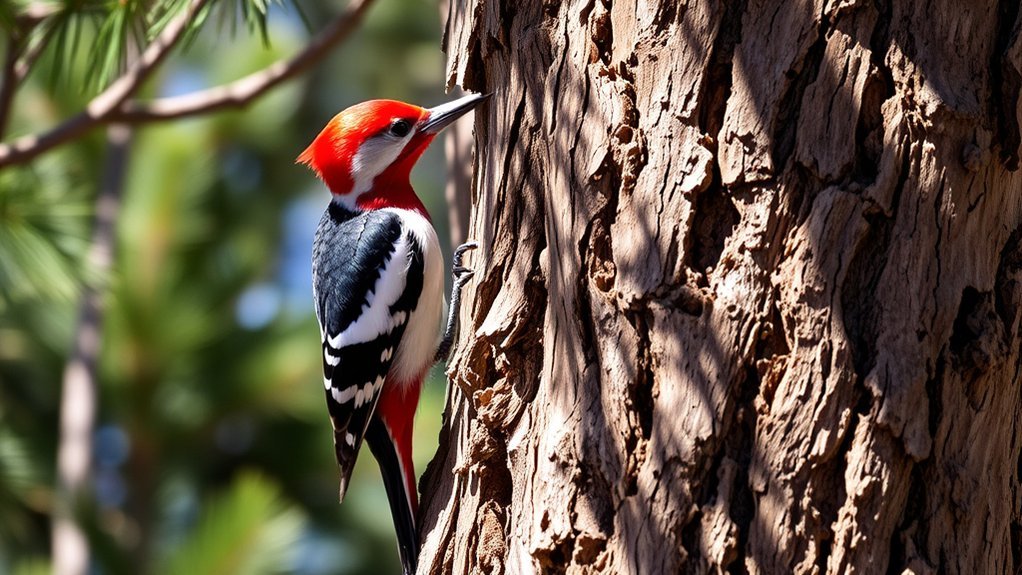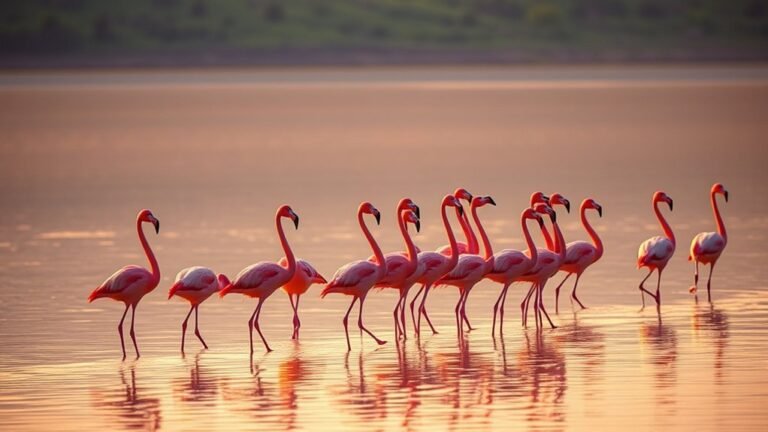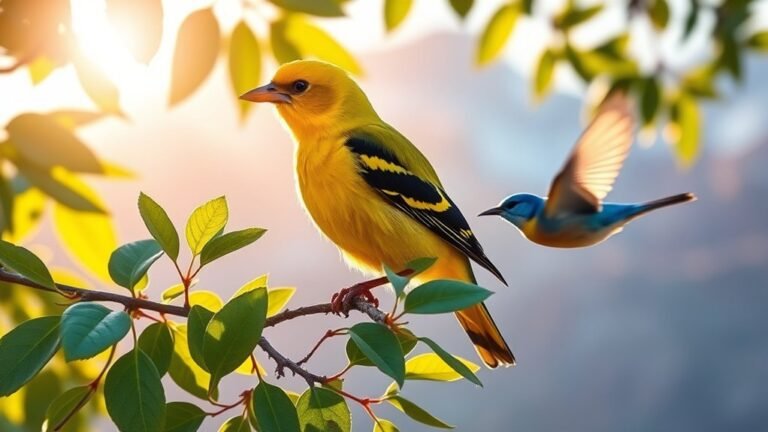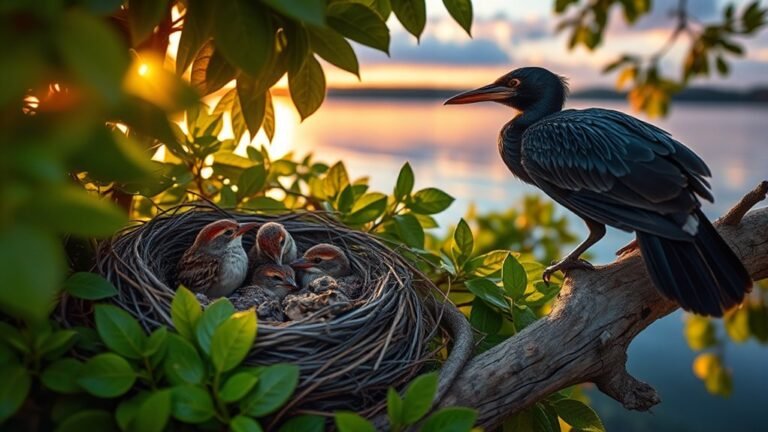Woodpeckers in Colorado: Identification Tips
In Colorado, you can spot different types of woodpeckers by learning about their special features and behaviors. For example, the small Downy Woodpecker looks different from the larger Hairy Woodpecker. Each type has its own calls, sizes, and ways of searching for food.
Listening to their calls and watching how they move can help you learn to tell them apart. If you're curious about their different traits and where you might find them, keep reading!
A Quick Overview
Here are some tips to help you identify woodpeckers in Colorado:
- Size Matters: Look at the size. Downy Woodpeckers are small, while Hairy Woodpeckers are bigger but look similar.
- Unique Markings: Check for special colors. The Red-naped Sapsucker has a bright red throat that makes it stand out.
- Feeding Behavior: Watch how they eat. Northern Flickers like to search for food on the ground. Most other woodpeckers peck on trees.
- Feather Patterns: Look at the different feather colors and patterns. Each woodpecker species has its own look, which helps you tell them apart.
- Sound it Out: Listen to their drumming sounds. Each type of woodpecker makes a unique drumming pattern to show their territory.
With these tips, spotting woodpeckers can be fun and easy!
Overview of Woodpeckers in Colorado
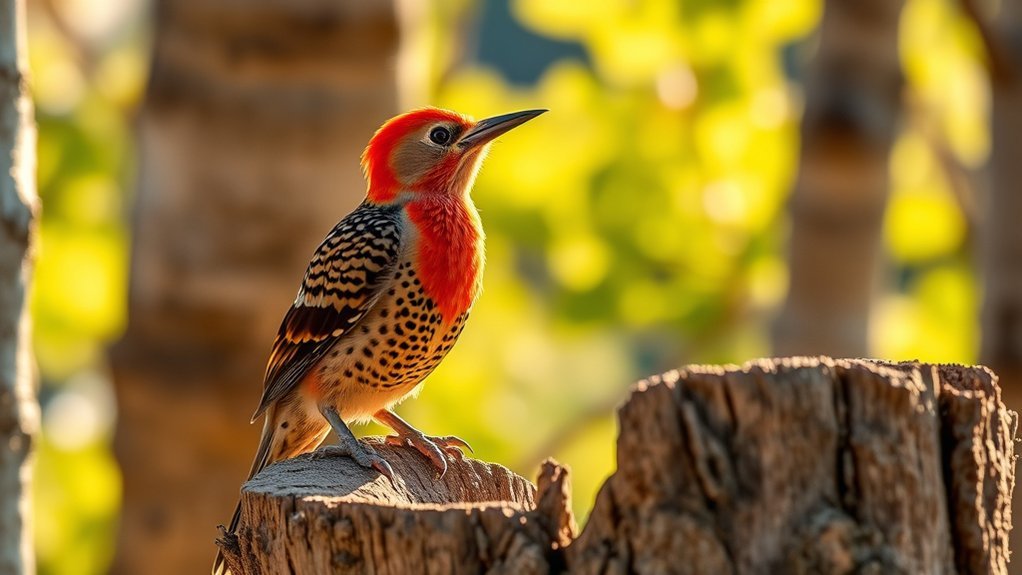
Woodpeckers are interesting birds that are found all over Colorado. They like different places to live, such as mixed forests, river areas, and city parks with plenty of trees. These birds have special skills that help them survive in various environments.
Some woodpeckers move to warmer places during the cold winter months in Colorado. They do this to find food and to breed. This migration shows how they adapt to changes in their surroundings.
Learning about woodpeckers helps us see their important role in nature. Each species contributes something unique to Colorado's wildlife. By appreciating these birds, we can enjoy the beauty of Colorado's nature even more.
Common Woodpecker Species
As you visit Colorado, you'll see some common woodpecker species. Each one looks and behaves a bit differently.
The Downy Woodpecker is small and has white spots on its wings. It usually pecks on trees with broad leaves.
The Hairy Woodpecker looks similar but is bigger. You can tell them apart by size.
You might also spot the Red-naped Sapsucker. This bird has a bright red throat and is known for making holes to drink tree sap.
Depending on where you are, these woodpeckers might live in different areas. For example, the Northern Flicker likes to look for food on the ground, especially in grasslands.
Learning about these birds helps you appreciate their roles in nature.
Take some time to notice these woodpeckers to enjoy the lively bird community in Colorado!
Unique Characteristics of Woodpeckers

When you look at woodpeckers, you'll see some cool things that make them special. Their beaks are shaped like chisels, which helps them dig into tree bark to find insects to eat. This beak also helps them make noise in their territory, which is called drumming.
Woodpeckers have beautiful feathers, too. Their colorful patterns can attract mates and help them blend in with their surroundings to avoid predators.
Knowing these facts can help you spot woodpeckers easier and appreciate how amazing these birds are. They're truly interesting creatures in nature!
Their Habitats and Distribution
Woodpeckers are found in many places. They live in thick forests, open woods, and even cities, as long as there are trees for them.
Woodpeckers are important for nature. They help keep insect numbers down and make homes for other animals. Knowing where they live can make birdwatching more fun.
Here are three important things woodpeckers need in their homes:
- Trees: Woodpeckers need trees to find food, build nests, and rest.
- Insects: They like places with lots of insects to eat.
- Dead Wood: Many woodpecker types use dead trees or old branches for nests and food.
Understanding these needs helps us appreciate where woodpeckers live. Next time you're outside, look for these habits and enjoy watching these amazing birds!
Identifying Woodpecker Calls

If you want to enjoy birdwatching more, learning woodpecker calls can really help! Each woodpecker species makes unique sounds. For example, the Downy Woodpecker has a soft, repeated "peep." The Hairy Woodpecker sounds sharper and louder.
Bigger woodpeckers, like the Pileated, make deep calls that can be heard far away.
To get better at telling these calls apart, try recording them and listening to them again. This practice will help you remember each sound.
Over time, you'll build a collection of woodpecker calls in your mind. This can make birdwatching even more fun!
Plus, sharing your knowledge of woodpecker calls can help you connect with other birdwatching fans. Enjoy listening!
Behaviors and Feeding Habits
Woodpeckers in Colorado have some interesting ways to find food. They're good at adapting their techniques to get insects and larvae that are hiding under tree bark.
Here are some of the main ways they find food:
- Drilling: They make holes in trees to find hidden insects.
- Gleaning: They pick insects off surfaces like leaves and tree trunks.
- Hawking: They catch flying insects in mid-air.
When it comes to nesting, woodpeckers make homes in dead or decaying trees. These cavities keep their young safe.
Knowing how woodpeckers behave helps us understand their important role in the ecosystem and why they're so interesting to watch.
Tips for Spotting Woodpeckers
Do you want to spot woodpeckers in Colorado? Here are some easy tips to help you see these interesting birds!
First, look for forests with different kinds of trees. Woodpeckers like to find food in trees that lose their leaves, known as deciduous trees.
Next, listen for their unique sounds. Woodpeckers tap on trees to make noise, and you can often hear them calling out. These sounds can help you find them.
Try watching early in the morning or late in the afternoon. This is when woodpeckers are usually active, so you have a better chance of seeing them.
Make sure to bring your binoculars so you can see them up close.
As you watch, look for signs like holes in tree trunks. These holes show where woodpeckers have been searching for food.
Being patient is important too. Stay quiet and still so you won't scare them away.
Joining a local birdwatching group can also be fun. You'll meet other people who love birds and can share tips and stories.
With these tips, you'll be ready for a great woodpecker spotting adventure! Enjoy your time watching these amazing birds.
Conservation and Protection of Woodpeckers
Woodpeckers are important for our forests. They help keep ecosystems healthy, but they face many problems. These problems include losing their homes, changes in our climate, and the use of harmful chemicals called pesticides.
Here are some simple ways you can help protect woodpeckers:
- Plant trees. Choose native trees and reduce grass areas in your yard. This gives woodpeckers a place to live.
- Speak up for safe practices. Encourage your community to use fewer pesticides. This keeps woodpeckers safe and healthy.
- Help local groups. Find and support organizations that work to protect bird habitats.
Frequently Asked Questions
What Is the Best Time to Observe Woodpeckers in Colorado?
If you want to see woodpeckers in Colorado, spring and early summer are the best times. During these seasons, woodpeckers are busy finding food and building nests. This means you have a better chance of spotting them while they go about their day. Enjoy watching these amazing birds in their natural homes!
Are Woodpeckers Aggressive Towards Humans or Pets?
Woodpeckers are usually not aggressive to people or pets. They are curious birds that like to explore rather than fight. When they see humans or pets, they often choose to stay away. Woodpeckers spend their time looking for food and chatting with other birds. If you see one, just enjoy watching it!
Can Woodpeckers Cause Damage to Trees or Homes?
Woodpeckers can hurt trees. They make holes in the bark and wood. This can make the tree weak. If woodpeckers get into your home, they may damage things like the siding or insulation. You might need to fix these problems soon.
How Can I Attract Woodpeckers to My Backyard?
To attract woodpeckers to your backyard, start by putting up special woodpecker feeders. Fill these feeders with suet, which is a type of fat that woodpeckers love. You can also plant native plants, as they provide natural food for woodpeckers.
Having both feeders and native plants will help bring these fascinating birds to your yard. Spend time watching them, and enjoy their visits!
Do Woodpeckers Migrate or Stay Year-Round in Colorado?
Woodpeckers can act differently when it comes to migrating. Some woodpecker species fly away to find warmer places or food in the winter. However, many woodpeckers choose to stay in Colorado all year long. They get used to the changes in the weather and find food where they live, so they don't need to migrate.
Whether they stay or go, woodpeckers have special ways to deal with their surroundings. So, next time you see one, think about how smart they are in making their choices!

Luna is the passionate founder and author of Birds and You, a website dedicated to sharing her love for birds with fellow enthusiasts. Through her engaging articles and guides, she aims to educate and inspire others to explore the fascinating world of birds. When she’s not writing, you can find Luna observing birds in their natural habitats or sharing beautiful bird photography on Pinterest. Join her on this journey to celebrate and protect our feathered friends!

